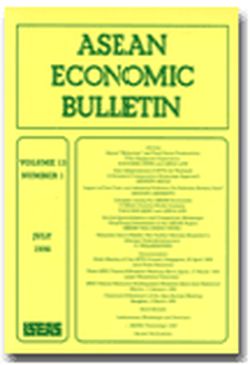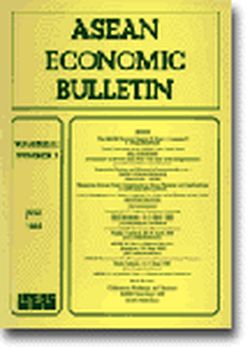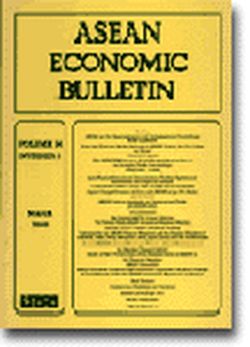ASEAN Economic Bulletin Vol. 15/2 (Aug 1998)

Date of publication:
August 1998
Number of pages:
156
Code:
AE15/2
Contents
-
Preliminary pages
-
Are the ASEAN Equity Markets Interdependent? see abstractThis article investigates the extent and structure of price linkages among five Association of Southeast Asian Nations (ASEAN) markets (Malaysia, Singapore, Philippines, Indonesia and Thailand), both in the long run and in the short run using co-integration based on the Johansen (1988) procedure, Granger causality and variance decomposition and impulse response analyses. The study finds that in the long term these markets are not significantly linked. However, in the short term, with the exception of Indonesia, all the ASEAN markets have significant linkages with each other. Malaysia is the most influential market while Singapore and Thailand are the markets with most linkages with other markets. Indonesia is not linked at all with any other ASEAN market.
-
An Investigation of Economic Linkages among the ASEAN Group of Countries see abstractThis study investigates existence of any economic linkages among the five founding members of the Association of Southeast Asian Nations (ASEAN), and explores the nature of these linkages. Based on the Vector Autoregression, variance decomposition and impulse response function analyses applied to quarterly real GDP data for the 1975â93 period, the results show the leading role of Indonesia and the significant economic linkages among them. The direction of causation and transmission is from Indonesia to the Philippines to Thailand to Malaysia and to Singapore. A two-way causation is found between Singapore and Malaysia. The study also finds the economic vulnerability of the ASEAN group of countries to changes in U.S. output, and the competitive nature between the Japanese and the ASEAN economies. These findings have important policy implications.
-
Market and Trade Outlook for the Food and Forestry Sectors of Latin America in the Asia-Pacific Basin see abstractThis article provides an overview of the current trade flows between Latin America (LAC) and Asia-Pacific Economic Cooperation (APEC) members in agricultural products, food, including seafood, and forestry products. It discusses the existing opportunities for further expanding this trade, from the Latin American perspective. The results show that APEC is an important market for food and forestry products from LAC, in spite of the physical distances. For economic ties between Asia and Latin America to be strengthened, it is important that alliances and co-operative relationships be built up between enterprises from the two regions. Certain improvements now discernible in the trade situation can be partially attributed to a range of facilitation activities undertaken under the APEC umbrella. Improved linkages between the food sectors of LAC and Asia would help the former to introduce new technologies and upgrade worker and management skills, thus stimulating growth of trade within APEC.
-
Can Open Regionalism Work in the Indian Ocean Rim Association for Regional Co-operation? see abstractWhether a regional economic co-operation under an âopen regionalismâ framework brings about expected economic gains cannot be judged from statistics alone. Attractive statistics for intra-regional trade and other trade-related indices such as intra-industry trade can be very deceptive. For the Indian Ocean Rim Association for Regional Co-operation (IOR-ARC), the basic fundamentals that are essential for the functioning of open regionalism are not in place. Regional economic co-operation, after all is a dynamic process that requires a firm commitment from member countries. For IOR-ARC, it is argued that this component is also lacking and the sharing of the Indian Ocean waters alone is not adequate to provide a blueprint for effective regional economic co-operation.
-
World Palm Oil Market under Freer Trade: Implications for Malaysia see abstractThe establishment of the WTO in 1995 moves the world economy into a new unprecedented era of comprehensive freer world trade, including agricultural trade. A host of vegetable oils are traded in the world market. These oils are highly interchangeable in many uses, as they exhibit minor differences in their physical and chemical characteristics. Massive government intervention over the years has influenced the existing patterns of trade in vegetable oils. This article discusses potential adjustments that would occur in world palm oil market when countries liberalized domestic protectionism and trade enhancement measures in vegetable oils under WTO rules. It is expected that trade liberalization in vegetable oils would benefit most the low cost producers of vegetable oils â Malaysia and Indonesia. For Malaysia, however, the combined factors of rising cost of farm production associated with increased labour wages as well as increasingly inelastic land supply for oil palm expansion potentially neutralize the benefits of trade liberalization in vegetable oils. Policy implications for Malaysia include the dire need to restructure the oil palm industry from its present focus on upstream activities towards high technology oleo-chemical industry.
-
Business Services and Institutional Support for Industrial Development in Vietnam see abstractThis study measures the current and prospective reliance of Vietnamâs industry on a detailed list of supporting services, identifies the binding constraints, and proposes practical measures for the government to overcome them. Particular categories of services that are found in short supply can be provided either by the public sector through the creation of new, or the strengthening of existing, institutions or by private businesses. In the latter case, a proactive role of the government entails the adoption of specific policy measures â or âfunctionalâ interventions â to entice private agents to move into particular segments of the service sector.
-
Ex Post Estimates of the Effects of the European Single Market Programme on the Exports of Developing Countries see abstractThe Single Market Programme in Europe (EC-92) was an ambitious attempt to create a common market. While EC-92 directives appeared to be outward-looking in their orientation, developing countries feared that the programme might lead to considerable trade diversion. Usually based on estimates by the Cecchini Report, ex ante analysis of the implications of EC-92 for the exports of developing countries generally suggested a positive effect, with strong EC-92-generated import growth swamping any diversion of developing-country exports due to the enhanced price-competitiveness effect. In this article, we revisit the question using two ex post approaches, that is an import-growth approach and a gravity model. According to our results, EC-92 directives appear to have had a negative effect on the exports of ASEAN and China, but not on those of the Asian NIEs. As expected, the effects were concentrated in light manufacturing and in some cases electrical machinery. The effect on ASEAN and on developing Asia in total was supported by the gravity-model approach.
-
DOCUMENTATION: ASEM2 Statement on The Financial and Economic Situation in Asia. London, 3 April 1998
-
DOCUMENTATION: 14th U.S.-ASEAN Dialogue, Manila, Philippines, 23-24 May 1998, Press Statement
-
DOCUMENTATION: Fourth ASEAN Ministerial Meeting on Haze, Singapore, 19 June 1998, Joint Press Statement
-
DOCUMENTATION: Meeting of the Fourth ASEAN Heads of Investment Agencies, Singapore, 24 July 1998, Joint Press Statement
-
BOOK REVIEW: Investing in Asia
-
BOOK REVIEW: Sending Workers Abroad
-
BOOK REVIEW: Economic Development and Prospects in the ASEAN: Foreign Investment and Growth in Vietnam, Thailand, Indonesia and Malaysia
-
BOOK REVIEW: Asia in Japan's Embrace: Building a Regional Production Alliance
-
Conferences, Workshops and Seminars; ASEAN Chronology 1998; Recent Publications






